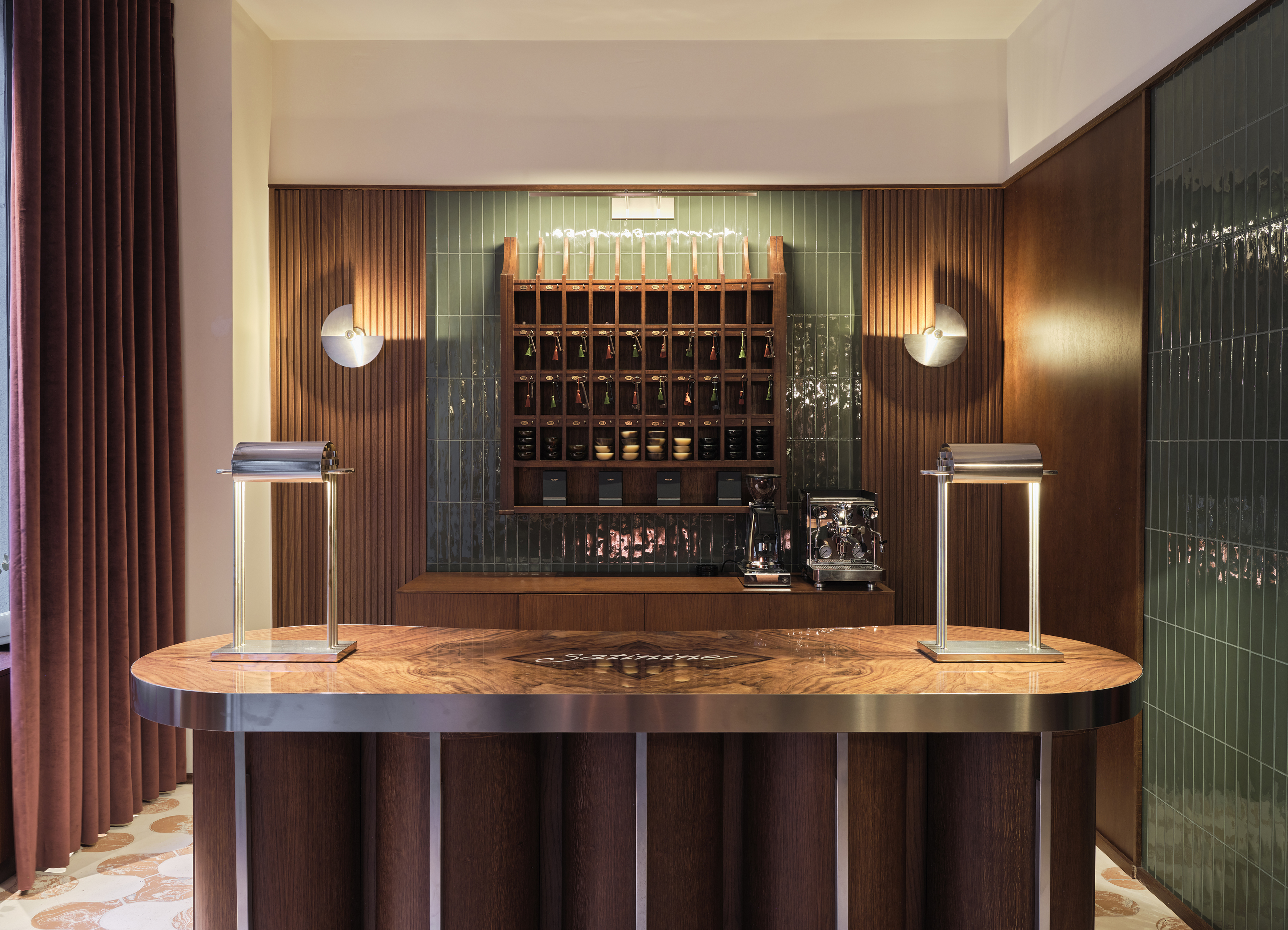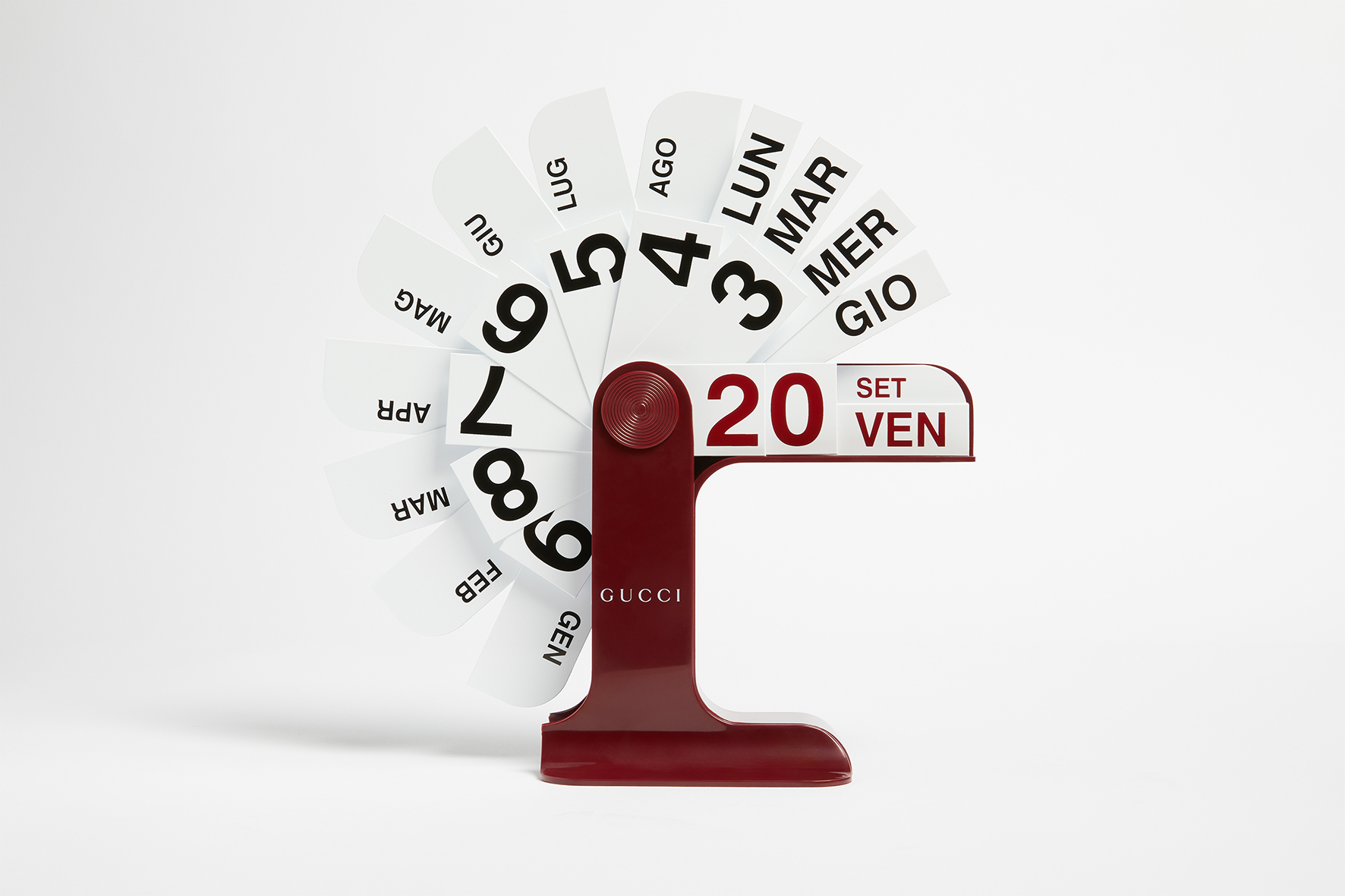Home grown: the Gucci Garden cultivates a green-fingered start to Pitti Uomo 93

Visitors to Pitti Uomo in Florence this weekend will be greeted by a giant illuminating neon-pink eye placed onto the façade of the ancient Palazzo della Mercanzia. It marks the opening of Gucci Garden, a magical, mercantile universe.
The city of Florence is widely regarded as the birthplace of the Renaissance, thanks to its role as a centre of European trade and finance in the medieval times. In the third millennium, it’s a fitting backdrop to creative director Alessandro Michele’s cultivated approach. His work is informed by a liberal embrace of the past. ‘This place makes you think that there is life here,’ he said, stood on the ground floor of the historic palazzo decorated with burnt yellow plaster walls and bright red lacquer, showcasing its arched doorways and windows. ‘This is a powerful, almost mythical place, not a dead place.’

The Gucci Garden Galleria is housed over two floors
The elegant building dates back to 1337 and was renovated by Gucci Museo in 2011. Since then it has stood as a cultural space and today will reopen in homage to the city of Florence and artisan workmanship. Part shop, part offbeat mansion – the palazzo has been reimagined as a living, collaborative monument to Gucci’s own renaissance.
On the ground floor sits a colourful bazaar, stuffed full of exclusive products. A bag is embossed with the title artwork of British illustrator and naturalist Henry Noel Humphreys’ The Genera of British Moths published in 1858; denim jackets are embellished with sacred animals, knitted jumpers have tigers, moths and butterfly’s on their fronts. Chairs embroidered with the heads of mythical beasts, ceramic plates, scented candles and bespoke stationery are all for sale too – each with their own special Gucci Garden label.

Chef Massimo Bottura's 'Gucci Osteria' restaurant on the ground floor
Across the stairs sits an intimate dining space lead by the acclaimed chef Massimo Bottura. Introducing his menu, he too talks of using past experiences to curate the now. His kitchen will be serving food that applies a range of international influences from Peru to Japan onto Italian classics. ‘Travelling the world, our kitchen interacts with everything we see, hear and taste,’ he says. ‘With eyes wide open, we look for the unexpected.’
The curator Maria Luisa Frisa has narrated the history of Gucci across six rooms. From its beginnings in Florence as a maker of leather accessories and luggage in 1921 to its modern day status as the apogee of millennial style. It is fitting that ‘Renaissance’ means rebirth. Standing in one room is a red chiffon blouse from Michele’s debut menswear collection for A/W 2015 – it is the look that has spearheaded a new interpretation of masculinity.
Frisa – whose show ‘Italiana: Narrating Italian History Through Fashion, 1971-2001’ – is due to open next month at Milan’s Palazzo Reale – has done away the hierarchy of time, displaying objects in themes rather than chronology. The first room ‘Guccification’ reclaims the iconic GG symbol as a work of pop art. In another room, Gucci’s long-standing love for flora and fauna is presented through archival and current season garments, silver animal statues made by the company in the 1950s and original artworks by the painter Vittorio Accornero – who was commissioned to create the original Gucci Flora print in 1966.
Throughout, the walls are decorated with works by artists Jayde Fish, Trevor Andrew (AKA GucciGhost) and Coco Capitán. Elsewhere a giant 19th century equestrian oil portrait, Fantino con bambina by Domenico Induno, which was acquired by the house in the 1980s, inspired a dress from the same period that stands in the exhibition. It is covered in a print of small riding boots. ‘This is a gallery and not museum,’ Frisa reminds us. The space, which opens to the public tomorrow is a marker of a brand continuously putting down creative roots.

The façade of the Palazzo della Mercazia in Florence, illuminated by a Gucci neon artwork

On the first and second floor, the Gucci Garden Galleria, co-curated by Maria Luisa Frisa, features the brand’s design pieces, memorabilia and ephemera organised into themes

In the Gucci Garden Galleria, items past and present are exhibited next to each other

Artists and Gucci collaborators Jayde Fish, GucciGhost and Coco Capitán have been enlisted to decorate the walls of the space
INFORMATION
For more information, visit the Gucci website
Receive our daily digest of inspiration, escapism and design stories from around the world direct to your inbox.
London based writer Dal Chodha is editor-in-chief of Archivist Addendum — a publishing project that explores the gap between fashion editorial and academe. He writes for various international titles and journals on fashion, art and culture and is a contributing editor at Wallpaper*. Chodha has been working in academic institutions for more than a decade and is Stage 1 Leader of the BA Fashion Communication and Promotion course at Central Saint Martins. In 2020 he published his first book SHOW NOTES, an original hybrid of journalism, poetry and provocation.
-
 New York's members-only boom shows no sign of stopping — and it's about to get even more niche
New York's members-only boom shows no sign of stopping — and it's about to get even more nicheFrom bathing clubs to listening bars, gatekeeping is back in a big way. Here's what's driving the wave of exclusivity
-
 The diverse world of Belgian embassy design – 'style and class without exaggeration'
The diverse world of Belgian embassy design – 'style and class without exaggeration''Building for Belgium: Belgian Embassies in a Globalising World' offers a deep dive into the architecture representing the country across the globe – bringing context to diplomatic architecture
-
 Pull up a bespoke pew at Milan’s new luxury perfumery Satinine, an homage to the city’s entryways
Pull up a bespoke pew at Milan’s new luxury perfumery Satinine, an homage to the city’s entrywaysDesigner Mara Bragagnolo fuses art deco details to bring storied Milanese fragrance brand Satinine into the 21st century
-
 Giant cats, Madonna wigs, pints of Guinness: seven objects that tell the story of fashion in 2024
Giant cats, Madonna wigs, pints of Guinness: seven objects that tell the story of fashion in 2024These objects tell an unconventional story of style in 2024, a year when the ephemera that populated designers’ universes was as intriguing as the collections themselves
-
 Fashionable Christmas baubles to accessorise this year’s tree, from Bottega Veneta to Loewe
Fashionable Christmas baubles to accessorise this year’s tree, from Bottega Veneta to LoeweSelected by the Wallpaper* style team, a gleaming array of Christmas baubles for fashion fans featuring fantastical designs from Bottega Veneta, Loewe, Prada and more
-
 Gucci’s ‘Blondie’ bag revival sees the enduring 1970s accessory reimagined anew
Gucci’s ‘Blondie’ bag revival sees the enduring 1970s accessory reimagined anewFirst shown at Sabato De Sarno’s Gucci Cruise 2025 show in London, a new iteration of Gucci’s beloved ‘Blondie’ bag fuses 1970s insouciance with a crisp modernity
-
 The breathtaking runway sets of S/S 2025, from beanbag animals to a twisted living room
The breathtaking runway sets of S/S 2025, from beanbag animals to a twisted living roomWallpaper* picks the best runway sets and show spaces of fashion month, which featured Bottega Veneta’s beanbag menagerie, opulence at Saint Laurent, and artist collaborations at Acne Studios and Burberry
-
 The invitation for Gucci’s latest show was a reissued Enzo Mari design classic
The invitation for Gucci’s latest show was a reissued Enzo Mari design classicMilan Fashion Week’s best invitation came from Gucci – a reissue of Enzo Mari’s ‘Timor’ perpetual calendar in the Italian house’s signature ‘Ancora’ oxblood red
-
 The A/W 2024 menswear collections were defined by a ‘new flamboyance’
The A/W 2024 menswear collections were defined by a ‘new flamboyance’Sleek and streamlined ensembles imbued with a sense of performance take centre stage in ‘Quiet on Set’, a portfolio of the A/W 2024 menswear collections photographed by Matthieu Delbreuve
-
 In fashion: the defining looks and trends of the A/W 2024 collections
In fashion: the defining looks and trends of the A/W 2024 collectionsWe highlight the standout moments of the A/W 2024 season, from scrunched-up gloves and seductive leather ties to cocooning balaclavas and decadent feathers
-
 In Tokyo, Gucci drafts local artisans to reimagine the Bamboo 1947 bag
In Tokyo, Gucci drafts local artisans to reimagine the Bamboo 1947 bagGucci’s ‘Then and Now’ exhibition in Tokyo celebrates 60 years of the Italian house’s presence in Japan. Here, local artisans tell Wallpaper* the story behind their contribution